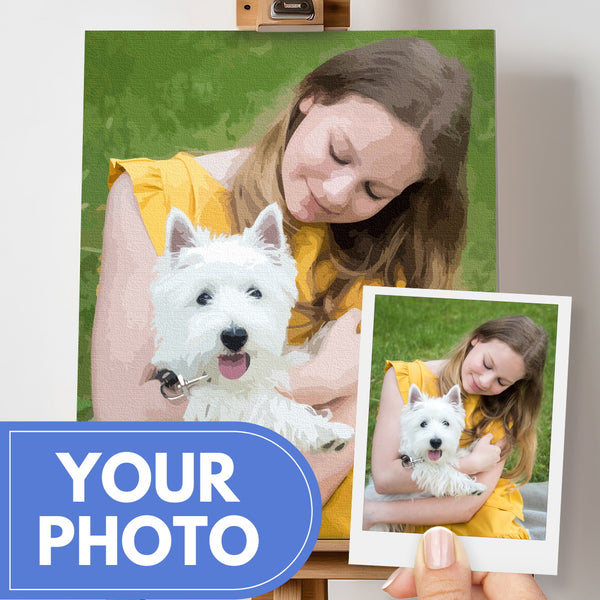What is Punch Needle? Everything you need to know about the embroidery technique of the moment!
Punch needle embroidery is THE new, exciting and fashionable form of embroidery for all levels. It will allow you to create bold accessories and beautiful projects for your interior decoration! In just a few years, punch needle has experienced a massive growth in popularity, driven almost entirely by social media. Here we explain how to make your first punch needle project.
WHAT IS NEEDLE PUNCHING?
A very simple relief embroidery technique, punch needle uses a special needle to punch loops of thread into fabric. You can achieve various unexpected and fun results by combining different types of wool yarns (colors, materials, thickness). It is a quick and easy process to experiment with to create items for the home such as cushions, paintings, or to create fashionable accessories. This art has been reinvented in recent years and has become the perfect addictive activity for those who enjoy therapeutic hobbies.
Before describing the different stages of needle punch in more detail, a bit of history... Punch needle embroidery dates back to at least medieval times and perhaps even to ancient Egypt. The technique was used to decorate religious vestments and to make rugs to pass the time on long sea voyages. The technique is said to have developed in Russia, before arriving in the United States in the 18th century.
STARTING OUT PUNCH NEEDLE EMBROIDERY

Needle punch is an activity that is very easy to learn and ideal for beginners. It also helps to develop self-confidence and is a very useful play activity in art therapy to learn to let go and relax. Punch needle allows for a wide range of projects in hobbies, but also in home decoration, perfect as gift ideas.
EVERYTHING YOU NEED TO PUNCH NEEDLE

In order to create relief embroidery, punch needle requires specific materials. For this purpose, the Figured'Art punch needle kits for beginners and enthusiasts consist of :
- A 26cm x 26cm pre-printed linen canvas
- Quality wool yarns: we make sure that in each kit, a sufficient quantity of wool is offered
- A punch needle tool
- A 20cm diameter embroidery hoop
- A nylon or metallic needle threader
- A punch needle tutorial to help you make your embroidery
We have selected a variety of patterns adapted to each of you, according to your tastes and preferences: landscapes, characters, animals... You can therefore vary the choices! Punch needle embroidery requires some practice to get the best results. But once you have found the right movements and the right rhythm, you will quickly achieve the desired results with precision.
HOW TO PUNCH NEEDLE FOR BEGINNERS?
If you are a beginner in punch needle, here are the different steps to master this technique:
Preparing the canvas:
Before starting to punch, you need a well-stretched canvas to work on. To do this, stretch the canvas in the punch needle frame:

Loosen the embroidery hoop by turning the screw counterclockwise

Place the canvas on the inner ring then lock it with the other part of the frame

Adjust the position of the fabric and tighten it

Tighten the frame screw, your canvas is ready to be used!
Threading your needle
The needle will be used to "punch" in your canvas. To do this, you will need to choose the color of wool to use and then thread your punch needle.

Pass the needle threader through the stem of the punch needle until the end of the handle.

On the handle side, pass the yarn through the loop of the needle threader.

Remove the needle threader from the stem side to thread the yarn through the punch needle.

Now pass the needle threader through the eye of the needle.

Then pull to bring the yarn out and adjust the length of the yarn that is coming out (7-8 cm). It should not be too short so that your yarn does not escape from the needle, nor too long as it will get in your way when you start embroidering.
Now Punch!
You are now ready to get serious! It's time to punch! Hold your frame in one hand and your needle in the other hand.

Stick the needle into the canvas until it is completely inserted.

Hold your punch needle so that the yarn is positioned at the bottom of the needle. Stick the needle in, then push the needle in all the way and remove it, but without lifting it off the fabric.
Be careful to keep the needle as close to the canvas as possible. If it sticks out too far, the thread will escape. By sliding the needle, you can then stick the next point and the tension of the fabric will keep the points in place. Stick it in and continue until the outline of an area is completed before filling the inside. Try to be as regular as possible, respecting the same gaps between two points. Repeat these steps until your canvas is finished. The yarn should be loose at the skein level.

Continue the part of the pattern of the same color and cut the yarn on the back.
And there you have it, your first raised stitches! On the right side, you have smooth points, and on the back, loops! For the more experienced among you, don't hesitate to vary the pleasures by alternating embroidery on the right and on the back of the canvas! If you want big loops on the front of the canvas, turn it over and stick your points on the back. This will create loops on the front and smooth and flat points on the back of your linen canvas. If, however, you prefer the appearance of smooth points, stick them on the front. These two techniques will allow you to create contrast and add volume to your work: long loops for a fluffy look or smooth and flat points, perfect for small figures or fine details!
Finally, you can add textile glue to the back of your work to make sure everything stays in place.
Each creation is unique, it depends on the places where you have poked and the space left between 2 points, so the final result may be different from the model image.
Good to know
- The oblique side of the needle must always be turned towards your next point. It is necessary to adopt the right gesture by making sure to keep it straight and keeping the eye of the punch needle always facing the canvas. You should always slide the needle keeping regular points, and this horizontally, from right to left if you are right-handed and vice versa for left-handers. To remove the needle, you will need to hold your yarn with your finger and remove the needle delicately so as not to undo your point. You can then cut the thread.
- Change the direction to punch, it is not the needle that should pivot but the frame!
- Start with small surfaces, and finish with larger surfaces.
- Stitch length: For surfaces smaller than 5cm, it is recommended to leave 2 to 3 holes between each punch. For slightly larger surfaces, leave 3 to 4 holes between each punch, and for larger surfaces such as backgrounds, it is advised to leave 4 holes or more between each punch.
- If the yarn becomes looser over time, simply pull the yarn from the back of the punch needle and start again.
I made a mistake while punching, what should I do?
But if you are not satisfied with your stitches, what should you do? It may well happen that you are not satisfied with the stitches made, especially when you are starting this activity. Do not worry, you just need to lift your needle and gently pull the yarn which will make your last stitches disappear. To make the holes from the previously made stitches disappear, simply scrape the canvas with the tip of the needle. If you run out of wool for a particular color, you may have punched too tightly, in which case you can undo and restart with greater intervals between 2 stitches.
You can now display your painting at home, or, if you are into sewing, use your punch needle project on cushions or accessories!
Believe us, once you start, you won't be able to stop!



